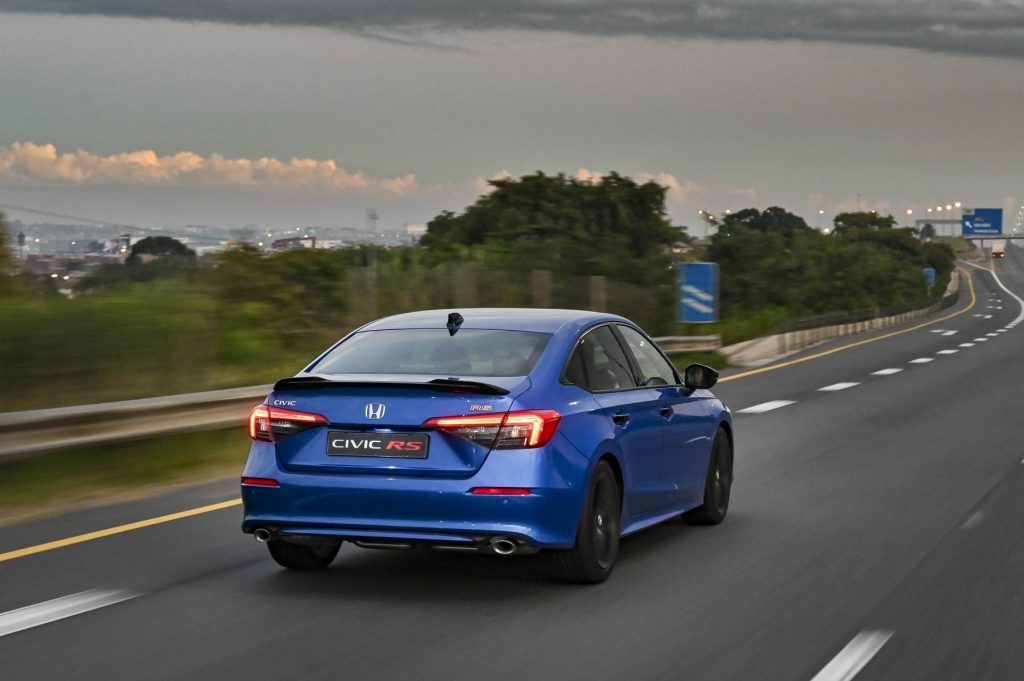The Honda Civic has come a long way since it first launched in 1972. Although it may not be the most exciting car by today’s standards, it did feature some cutting-edge features for its time: “simulated” wood inserts on the dash, reclining vinyl bucket seats. What’s the 1970s version of Instagram? Bulletin Boards? It’s #Vinyl.
The oil crisis of 1973 saw oil prices triple and the Honda Civic represented a global game-changer at the time with its frugal 1.2-litre engine. In fact, it was such a hit that carmakers like VW and Ford took notice and followed suit in using the same front-wheel-drive hatchback formula that saw the birth of the Golf and Ford Fiesta.
Fast-forward 50 years and 27 million sales worldwide, and the Civic is back in South Africa in its 11th iteration. It wears an RS badge. But before you go on social forums to express your outrage at Honda’s audacity to replace the iconic Type R, just bear with me. The Type R is still very much in the pipeline and will hopefully arrive next year. Until then, the RS is what we are getting.
It’s a confusing naming choice because, well, it doesn’t represent iconic terms such as Rally Sport, Racing Sport, or anything really that evocative. Rather, and this is a bit awkward, RS portrays Honda’s “Road Sailing” philosophy. I could almost hear the chirping of crickets as I typed that.
Is it a bad thing? Heck no. It still very much embodies the Civic character to which I’ve lost countless traffic light drag races in my teens. Just more grown up but still very much Civic at its heart.
Styling
I’ll save you the “rising beltline” and “accentuated sporty appeal” terminology and just state that the new Honda Civic has undergone an aggressive restyle that is very much in line with the new generation of Hondas rolling off the factory floor. It shares some creative similarities with the likes of the HR-V, although in the case of the Civic, I’m of the opinion that these lines serve the singular purpose of making it aesthetically pleasing.
The front of the car looks purposeful; the side profile lends it an aerodynamically-sleek look because it’s also 25mm longer than the outgoing model. I’m still not sure about the stylistic choice of the oversized rear lamps, though. Often, less is more.

Inside
Nowhere is Honda’s attention to detail more apparent than on the inside. The Honda Civic RS comes with a beautiful interior. Some factoids? The windscreen offers an 87-degree view angle, so visibility is stellar. Honda has even given consideration to minute, easy-to-overlook details such as the spring-feel of buttons and switchgear to create a cabin that is, well, an amazing place to be.
The hexagonal mesh insert that spans the width of the dash and hides the air vents takes the centre stage of the interior’s vocal points. On top of the dashboard is a 9″ infotainment system that looks to simplify operations with welcome functions such as customisable shortcuts for the most often used apps and functions.
It’s also the control hub for the Civic’s connectivity features such as Apple CarPlay and Android Auto that comes standard, supplemented by an available-as-standard 12-speaker Bose sound system. Audiophiles are sure to appreciate the quality of sound this delivers. But it must be said that connecting a cell phone proved quite finicky. As we later learned, a dedicated data transfer cable is a must, but even in the absence of one, the system couldn’t maintain a consistent Bluetooth connection.
Driving
How does the Civic RS drive? Well, if you’re curious to know if it has any semblance to the traditional adorned-to-hasty-hatches RS badge. No, not quite. Sorry. As far as (R)oad (S)ailing goes,that’s pretty much a bang-on description of its cruising ability.
Even with its 18″ wheels wrapped in sporty Michelin rubber, it’s an exceptional cruiser. It doesn’t waft, nor does it jar any bones, even on poorly-maintained road surfaces. It just strikes a perfect balance. It’s relatively quiet as well in terms of noise, vibration and harshness.
Propelling the Civic is a 1.5-litre turbocharged engine that Honda says has been extensively tinkered with to deliver 131kW and 240 m of torque. Sure, it reads on the side of modesty, but while this is no drag-strip-tearing RS, it has more than enough poke to provoke an appreciative smile. And here’s the kicker: power is delivered to the wheels through a CVT gearbox. As much as it pains me to admit this, in the Civic RS, it works. Quite well, if I’m honest. It’s responsive, reasonably direct and although there is still audible whining (drowned out by the Bose sound system for the most part) Honda has taken care to reduce the rubber-band effect these boxes are often associated with and it shows. It’s also helped by the generous torque from the turbocharged engine.
In summary
The Honda Civic RS comes brimmed with style, general likeability and a full-house of kit including adaptive cruise control, lane-keep assist and a bevy of acronyms that include the usual suspects like ABS and EBD. Yet, it’s considerably more affordable than spec-for-spec German competitors.
Honda ticked all the requisite boxes on this one, and if you’re shopping in this segment and not considering the Civic RS at R669 000, you’re doing yourself a disservice.